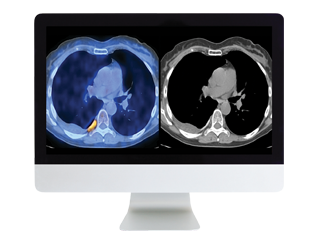Practical PET/CT: What You Need to Know
PET/CT is an essential imaging study, largely serving the fields of oncology and neurology, that combines the sensitivity of providing physiologic data about pathologic conditions with the diagnostic capability of CT. This course focuses on many important practical issues in PET/CT, optimizing PET/CT protocols and image production, as well as interpretation and optimizing communication. Particular attention is placed on the most recent updates and role of PET/CT in cancers diagnosis and treatment. Updates in dementia imaging with amyloid agents and F18-FDG are also discussed.
Earn credit at your own pace through November 6, 2020 and continue to access your videos until November 7, 2027. See below for detailed information and learning outcomes.

This course offers 10.5 CME/SA-CME Credits following completion of an online test.
ARRS Member price: $495
ARRS In-Training Member price: $249
Nonmember price: $999
Order Now
Video content for this Online Course will be available to view until November 7, 2027, which is ten years following the issuance date of this course. ARRS reserves the right to remove video content before the end of the ten year period. Video content that contradicts current science or misleads the viewer based on changes to accepted clinical practice may be removed on a case-by-case basis.
Learning Outcomes and Modules
After completing this course, the learner should be able to:
- describe the appropriate use of PET/CT including oncologic and neurologic indications
- identify normal variants and pitfalls that can confound PET/CT interpretation
- discuss the latest updates in using PET/CT in a variety of cancers
- describe how to interpret PET/CT systematically
- dictate reports
Module 1
- History of PET and Clinical Overview—Marc Seltzer, MD
- Importance of Patient Preparation—Don Yoo, MD
- Optimizing PET/CT Protocols—Terence Wong, MD, PhD
- Improving Your PET/CT Practice: Lessons Learned in Clinical Practice—Harry Agress, MD
Module 2
- Important Normal Variants and Pitfalls I—Esma Akin, MD
- Important Normal Variants and Pitfalls II—Katherine Zukotynski, MD
- PET/CT for Infection and Inflammation—Don Yoo, MD
Module 3
- Update on PET/CT in Lung Cancer—Rathan Subramaniam, MD, PhD
- Update on PET/CT in Lymphoma—Katherine Zukotynski, MD
- Update on PET/CT in Head and Neck Cancer—Marc Seltzer, MD
Module 4
- Update on PET/CT in GU Malignancies—Mark Nathan, MD
- Update on PET/CT in Prostate Cancer—Mark Nathan, MD
- Interpreting F18-FDG and Strategies for Challenging Cases—Phillip Kuo, MD, PhD
- Moving to the Next Level: What Defines a True PET/CT Expert—Harry Agress, MD
Module 5
- Update on PET/CT in Melanoma—Eric Rohren, MD
- Update on PET/CT in GYN Malignancies—Esma Akin, MD
- PET/CT for Evaluation of Treatment Response—Rathan Subramaniam, MD, PhD
- Update on the Role of Amyloid Imaging and Interpretation—Phillip Kuo, MD, PhD
Module 6
- How to Generate a Great PET/CT Report—Eric Rohren, MD
- Important New Developments in PET—Terence Wong, MD, PhD
- The Most Instructive and Challenging PET/CT Cases—Don Yoo, MD
The American Roentgen Ray Society (ARRS) is accredited by the Accreditation Council for Continuing Medical Education (ACCME) to provide continuing medical education activities for physicians.
The ARRS designates this enduring material for a maximum of 10.5 AMA PRA Category 1 Credit(s)™ and 10.5 American Board of Radiology, MOC Part II, Self-Assessment CME (SA-CME) credits. Physicians should claim only the credit commensurate with the extent of their participation in the activity.